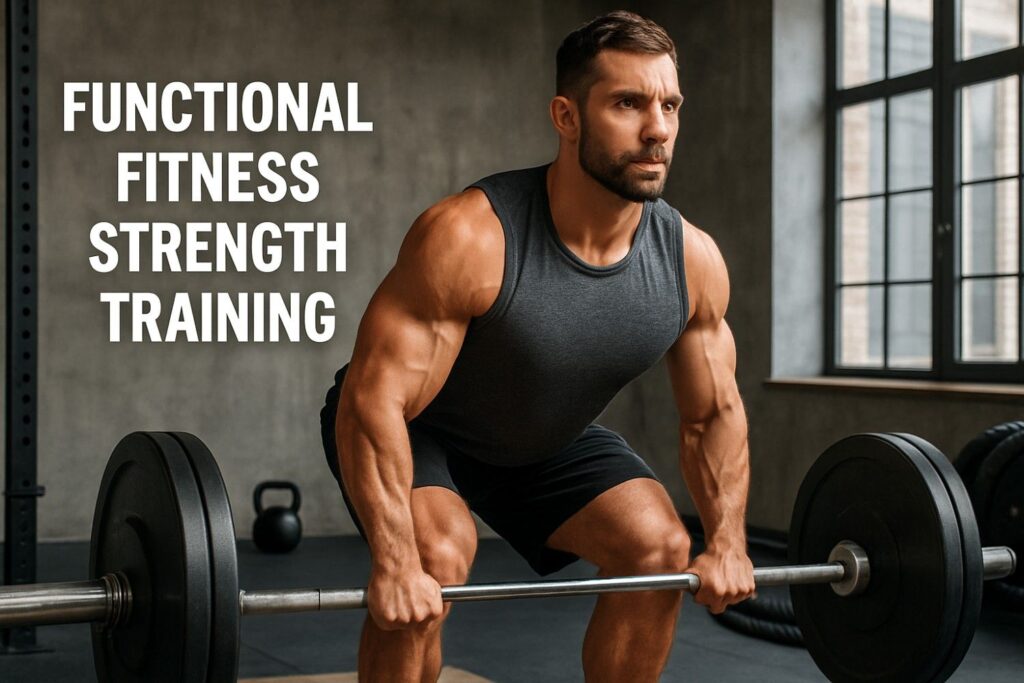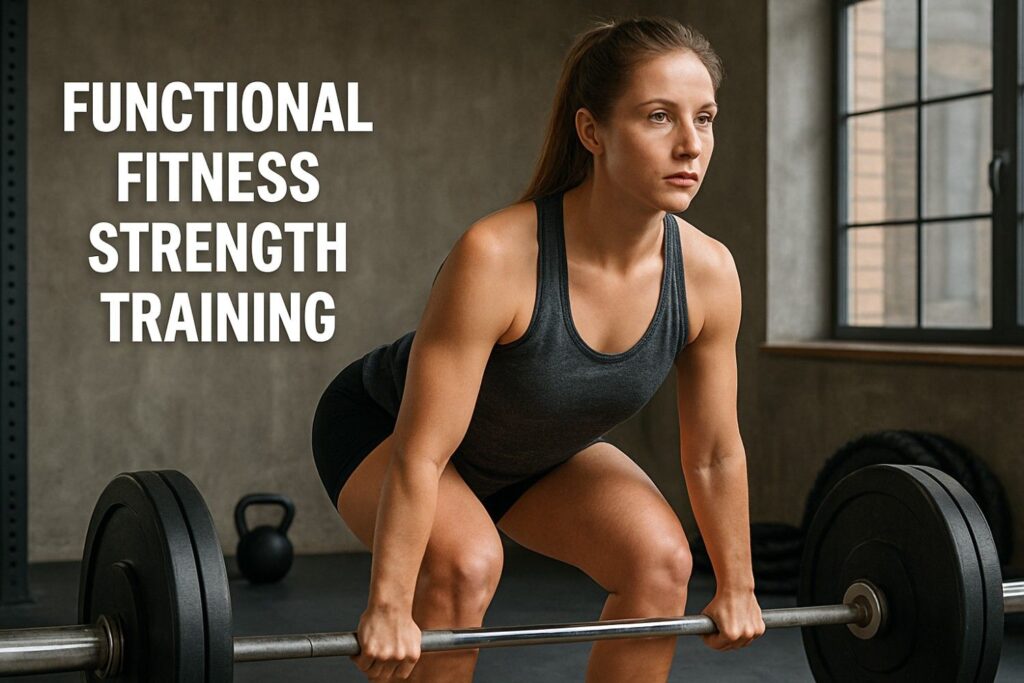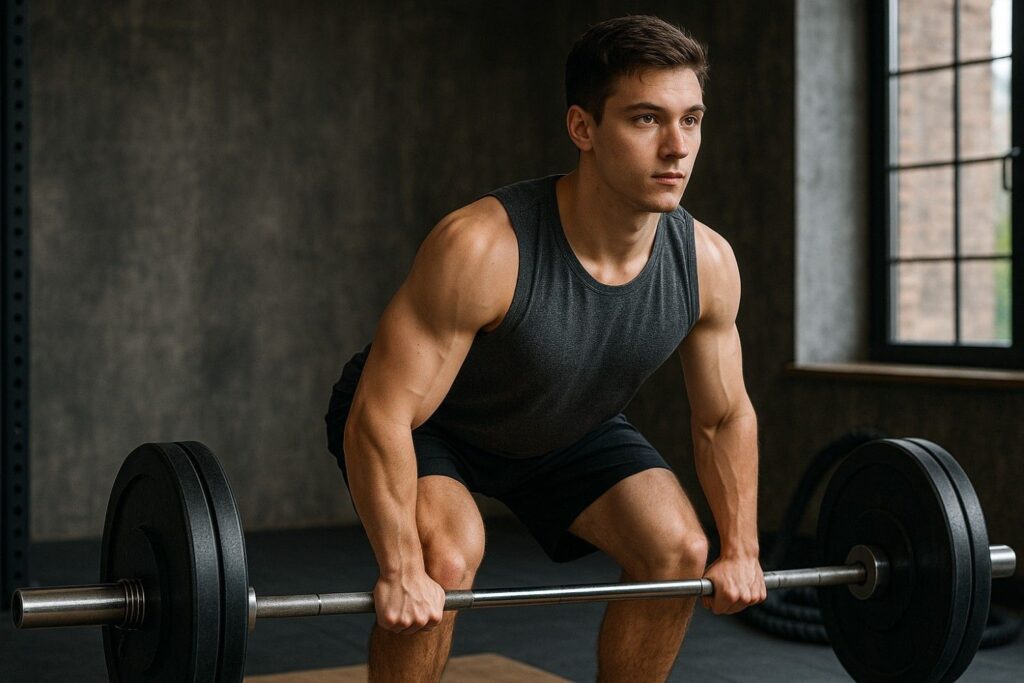Introduction: Why Functional Fitness Strength Training Is the Smart Way to Work Out
Let’s face it working out isn’t just about looking good anymore. These days, more people are asking, “How can I move better, feel stronger, and avoid injuries?” That’s exactly where functional fitness strength training comes in. Instead of isolating muscles just for show, this training style focuses on building strength that you can actually use in daily life whether you’re lifting groceries, climbing stairs, or playing with your kids.
What sets it apart, first and foremost, is its emphasis on real-world movement patterns. Unlike traditional workouts that often stick to rigid machines or repetitive motions, functional training helps your body learn how to move with power, balance, and control in all directions.
Moreover, it doesn’t just make you stronger it helps you become more resilient. By training multiple muscle groups together, you improve coordination, core stability, and joint mobility. As a result, you’re far less likely to tweak your back bending over or strain your shoulder reaching for something overhead.
Even better, this style of training is adaptable for all fitness levels. Whether you’re a beginner or a seasoned athlete, you can scale functional exercises to match your current ability and progress over time.
In short, functional fitness strength training is more than just smart it’s sustainable, efficient, and built around the way your body was designed to move.
What Is Functional Fitness Strength Training?
Let’s break it down.
Functional fitness strength training is all about training your body to move the way it’s meant to move naturally, efficiently, and with purpose. Instead of focusing on just how much weight you can lift or how big your muscles look, this approach shifts the focus to how well your body works in real life.
Think about it: every day, you bend, twist, push, pull, squat, and lift. Whether you’re carrying groceries, getting up off the floor, or reaching for something on a high shelf, your body is constantly performing complex movements not isolated ones.
That’s exactly where Functional fitness strength training comes in. It trains your muscles to work together, just like they do in everyday situations.
So, how is it different from traditional Functional Fitness strength training?
Well, while a leg press machine targets your quads in a fixed position, a functional move like a goblet squat activates your core, glutes, hamstrings, and even your balance all at once. Similarly, a kettlebell swing mimics the explosive motion you’d use to pick up a heavy box or sprint after a bus. You’re not just getting stronger you’re getting more capable.
In other words, it’s not about training muscles in isolation it’s about training movements.
Furthermore, functional strength training often includes:
- Bodyweight exercises
- Unstable surfaces (like balance boards or Bosu balls)
- Multi-joint movements (think lunges, deadlifts, and carries)
- Tools like kettlebells, resistance bands, and sandbags
Over time, this kind of training improves your mobility, coordination, balance, and core strength not to mention, it significantly reduces your risk of injury.
Key Principles of Functional Fitness Strength Training
- Multi-joint, compound exercises (e.g., deadlifts, lunges, carries)
- Full-body muscle engagement for improved movement patterns
- Core stability to protect your spine and support your posture
- Mobility training to keep joints healthy and strong
- Injury prevention through controlled, functional movement
Instead of asking how much you can lift, functional training asks how well you can move.
Functional Fitness Strength Training vs Traditional Strength Training
To fully appreciate functional training, let’s compare it to traditional strength training:
| Aspect | Traditional Training | Functional Fitness Strength Training |
|---|---|---|
| Focus | Aesthetics, muscle hypertrophy | Real-world movement, strength, injury prevention |
| Movements | Isolated, linear (e.g., curls, leg press) | Multi-planar, compound (e.g., squats, carries) |
| Equipment | Machines, barbells | Bodyweight, kettlebells, resistance bands |
| Planes of Motion | Mostly sagittal (forward/backward) | Includes frontal and transverse (sideways, rotation) |
| Risk of Injury | Higher if form is poor or muscles are imbalanced | Lower due to joint-friendly movement patterns |
Bottom Line: Functional training builds usable strength that goes beyond the gym.
Why Functional Fitness Strength Training Works
It Enhances Real-Life Performance
Let’s face it most of us don’t train just to impress people at the gym. We train to feel better, move easier, and stay strong in everyday life. That’s exactly where functional fitness strength training shines.
Unlike traditional workouts that isolate muscles for the sake of appearance, functional training teaches your body to move the way it was built to as a unit, not in pieces. Think about it: when you carry groceries, pick up your kid, or climb stairs, you’re not using just your biceps or quads. You’re using a combination of muscles working together in coordination.
That’s the magic of functional training.
Because it focuses on movement patterns like pushing, pulling, lifting, rotating, and balancing, it prepares your body for real-world tasks. As a result, you’re not just stronger in the gym you’re stronger in your everyday routine.
For example, a kettlebell swing improves hip power and posture, which can translate into better lifting mechanics when grabbing something off the floor. Likewise, exercises like step-ups mimic climbing stairs or hiking, while Turkish get-ups train your body to move from the ground to standing something incredibly useful at any age.
Even better, these movements activate your core, improve balance, and build stability so you’re not only performing better but also reducing your risk of injury in the process.
In short, functional fitness strength training doesn’t just make you look strong it helps you feel strong where it actually counts: in the real world.
It Boosts Neuromuscular Connection
One of the biggest reasons functional fitness strength training is so effective comes down to something you can’t see in the mirror the neuromuscular connection. Simply put, this is how well your brain and muscles communicate.
Now, here’s where it gets interesting.
When you do traditional exercises like bicep curls or leg presses, you’re mostly working in one fixed path. These movements don’t require much coordination they just isolate one muscle and go through the same range of motion over and over.
On the other hand, functional movements like kettlebell swings, lunges with rotation, or planks with shoulder taps demand more from your body. Not only are you using multiple muscle groups at once, but you’re also challenging your balance, coordination, and stability. As a result, your brain has to work harder to fire the right muscles at the right time.
Over time, this constant communication between your brain and body gets sharper. You move more efficiently, react faster, and maintain better control during workouts and in everyday life, too. Whether you’re climbing stairs, dodging a kid running through the hallway, or catching yourself from slipping on a wet floor, your body will respond quicker and more confidently.
In short, According to a study from the Journal of Strength and Conditioning Research, functional strength workouts improve neuromuscular efficiency how well your brain communicates with your muscles. This leads to better coordination and more efficient movement patterns.
It Builds Core Strength and Stability

First of all let’s clear up a common misconception your core isn’t just your abs. In fact it includes everything from your hips and lower back to the deep muscles around your spine. These muscles work together like the foundation of a house if they’re weak or unstable, everything else (from your posture to your balance) starts to crumble.
That’s where functional fitness strength training really shines.
Unlike traditional workouts that isolate muscles (like crunches for abs or back extensions), functional training engages your core in nearly every movement. Think about exercises like planks, kettlebell swings, or lunges with rotation your core is constantly stabilizing, supporting, and reacting. And the best part? You’re not just working your core you’re training it the way you actually use it in real life.
As a result, your core becomes stronger from all angles. You start to notice improved balance, better coordination, and fewer aches during everyday tasks like bending, lifting, or even standing for long periods.
Moreover, a strong core helps protect your lower back, improves posture, and boosts overall athletic performance. So whether you’re chasing after your kids, hauling groceries, or hitting a tennis ball, your core has your back literally.
In short, functional fitness strength training doesn’t just give you core strength it gives you core confidence.
It Supports Healthy Aging
Research from Harvard Health shows that functional training significantly improves balance and reduces the risk of falls in older adults. It’s a lifelong fitness solution.
My Journey with Functional Fitness Strength Training
To be honest, I didn’t discover functional fitness strength training because I was ahead of the curve. In fact, it came out of frustration.
At the time, I was following a typical gym routine split days, heavy lifts, and machines for every muscle group. On paper, I was strong. I could bench, squat, and curl more than ever. But oddly enough, I didn’t feel strong. My lower back ached after long car rides, I struggled with basic flexibility, and one day I tweaked my shoulder just reaching for something in the back seat. That was the wake-up call.
So, I started digging.
First, I scaled things back and focused on bodyweight movements. Then, I added in kettlebells, resistance bands, and more mobility work. I stopped chasing numbers and started paying attention to how I moved how I felt after each session.
Gradually, things began to change.
I felt lighter on my feet. Tasks that used to leave me sore like hauling groceries or hiking became easier. More importantly, I stopped getting injured. For the first time, my workouts weren’t breaking me down; they were building me up.
Over time, functional training became more than just a new fitness method. It became a mindset. Instead of training to look good, I trained to live well.
Now, I still lift heavy. But I also carry odd objects, crawl, rotate, balance, and breathe better. And the results? They’re not just in the mirror they’re in my day-to-day life.
How to Start a Functional Fitness Strength Training Routine
Getting started with functional fitness strength training doesn’t have to be complicated or intimidating. In fact, the beauty of this approach lies in its simplicity and practicality. Whether you’re brand new to strength training or looking to break out of a rigid gym routine, you can ease into it with just a few smart changes.
Let’s walk through how you can begin, step by step.

Beginner-Friendly Functional Fitness Strength Training Workout
If you’re new to functional fitness strength training, don’t worry you don’t need fancy equipment or years of experience to get started. In fact, some of the best foundational movements use just your body weight, a kettlebell, or a resistance band.
Let’s walk through a simple yet effective full-body routine. This workout is designed to build strength, improve mobility, and boost stability, all while preparing your body for real-life activities like lifting groceries, climbing stairs, or even chasing after your kids.
Here’s a full-body, scalable routine to help you get started:
Warm-Up (5-10 minutes)
- Jumping jacks
- Hip openers
- Arm circles
- Bodyweight squats
Core & Stability (5-10 minutes)
- Plank with reach
- Bird dogs
- Single-leg balance
Main Strength Circuit (30 minutes)
Complete 3 rounds of:
- Kettlebell Deadlifts (10 reps)
- Goblet Squats (10-12 reps)
- Push-Ups or Landmine Press (10 reps)
- Step-Ups with Knee Drive (10 each leg)
- Renegade Rows (10 each side)
Focus on controlled movement and full range of motion.
Cooldown & Mobility (5 minutes)
- Deep belly breathing
- Foam rolling
- Seated hamstring stretch
- Thoracic spine rotation
Getting the Most Out of Functional Fitness Strength Training
When it comes to functional fitness strength training, consistency and smart choices are key. It’s not about going hard every single day, but about building a routine that works for you in the long term. Here’s how to get the most out of your workouts:
Tips for Long-Term Success
Train Movements, Not Just Muscles
One of the most important shifts you’ll make is thinking beyond individual muscles and focusing on movement patterns. Instead of just doing bicep curls or leg presses, you’ll work on multi-joint movements that involve your entire body. For example, squats, deadlifts, and kettlebell swings target multiple muscles at once and mimic real-world actions. This means you’ll be training your body for the way it moves in daily life, not just for aesthetic gains.
So, next time you’re in the gym or at home working out, think: What movement am I training, not just what muscle am I targeting?
Use a Variety of Tools
Another tip for maximizing functional fitness is to mix up your equipment. Kettlebells, resistance bands, medicine balls, and even your own bodyweight can all be used to create a more diverse workout that challenges your body in different ways. Machines might be convenient, but they often lock you into specific movement patterns. On the other hand, using a variety of equipment lets you work on balance, coordination, and core stability all essential components of functional strength.

For instance, kettlebell swings are excellent for building power, while resistance bands help improve mobility and control. Incorporating different tools into your routine keeps things interesting and engages your muscles in ways that machines can’t.
✅ Include unilateral exercises to fix strength imbalances
When it comes to functional fitness, balance matters. Unilateral exercises like lunges or single-leg deadlifts work one side of the body at a time. These exercises are especially helpful because they highlight any imbalances you might have between the left and right sides. Plus, they challenge your stability and improve core engagement.
So, whether you’re doing a single-leg squat or holding a kettlebell in one hand during a deadlift, make sure to include unilateral exercises in your routine. They’ll help you build strength in a more balanced way, ensuring that your body is prepared for anything life throws at it.
✅ Make mobility part of your routine, not an afterthought
Strength isn’t just about lifting heavier weights mobility is equally important for long-term results. In functional fitness, mobility exercises allow your muscles and joints to move through their full range of motion, reducing the risk of injury and improving overall movement quality. After all, what good is strength if you can’t move freely?
Incorporating mobility work into your warm-up and cool-down is a great way to ensure that your body stays flexible and ready for action. Simple exercises like hip openers, shoulder rolls, and dynamic stretches can make a huge difference in preventing tightness and stiffness.
✅ Don’t chase reps-chase quality of movement
Lastly, focus less on hitting a specific rep count and more on performing each movement with control and precision. The goal of functional fitness strength training is to train your body for efficient movement rather than just building muscle. Prioritize quality over quantity make sure you’re using the correct form, engaging the right muscles, and moving through each exercise with intention.
As you progress, you’ll notice that you don’t just get stronger in the gym, but you also feel stronger in your everyday life whether that’s lifting groceries, playing with your kids, or simply walking up stairs without feeling winded.
Additional Resources to Deepen Your Training
Harvard’s Guide to Functional Fitness
NASM: Functional Training for Injury Prevention
Men’s Health: Functional Workout Ideas
Read our internal guide on Mobility Training for Beginners to complement your routine.
What’s Your Functional Goal?
Have you tried functional fitness strength training before?
What’s one real-life movement you’d like to get stronger at?
Leave a comment below or check out our Free Functional Training Starter Guide. And if you want expert tips sent straight to your inbox each week, subscribe to our newsletter we’ve got your back.

It’s helpful